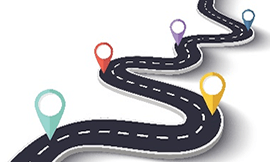Think about a time you’ve looked at the week ahead and planned trips to coincide with times and streets with low traffic density. Maybe you combined trips, such as shopping and dropping off/picking up children from school. These are simple examples of journey management in your personal life. The approach to reduce miles driven and exposure to road hazards can be applied in a more systematic way in the workplace.
Components:
• A policy that contains site-specific assessments of transportation-related hazards and what steps will be taken to minimize these hazards
• A process to assess the need for trips and seek to eliminate unnecessary trips
• A procedure for managing trips, including safe route planning and minimizing driving and environmental risk and the distances driven in a single trip
Benefits:
• Eliminate unnecessary driving, lessening the risk of a crash
• Minimize exposure to road traffic hazards
• Reduce fuel costs; Reduce wear and tear on vehicles; Reduce liability; Increase efficiency
The bottom line: journey management has clear safety benefits and cost savings.
Read more
From: CDc.gov







